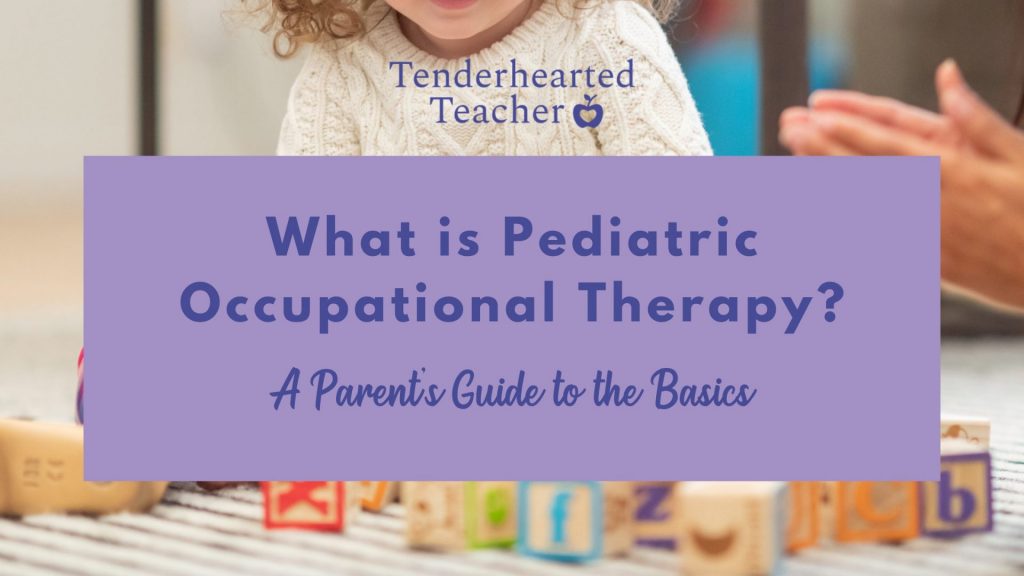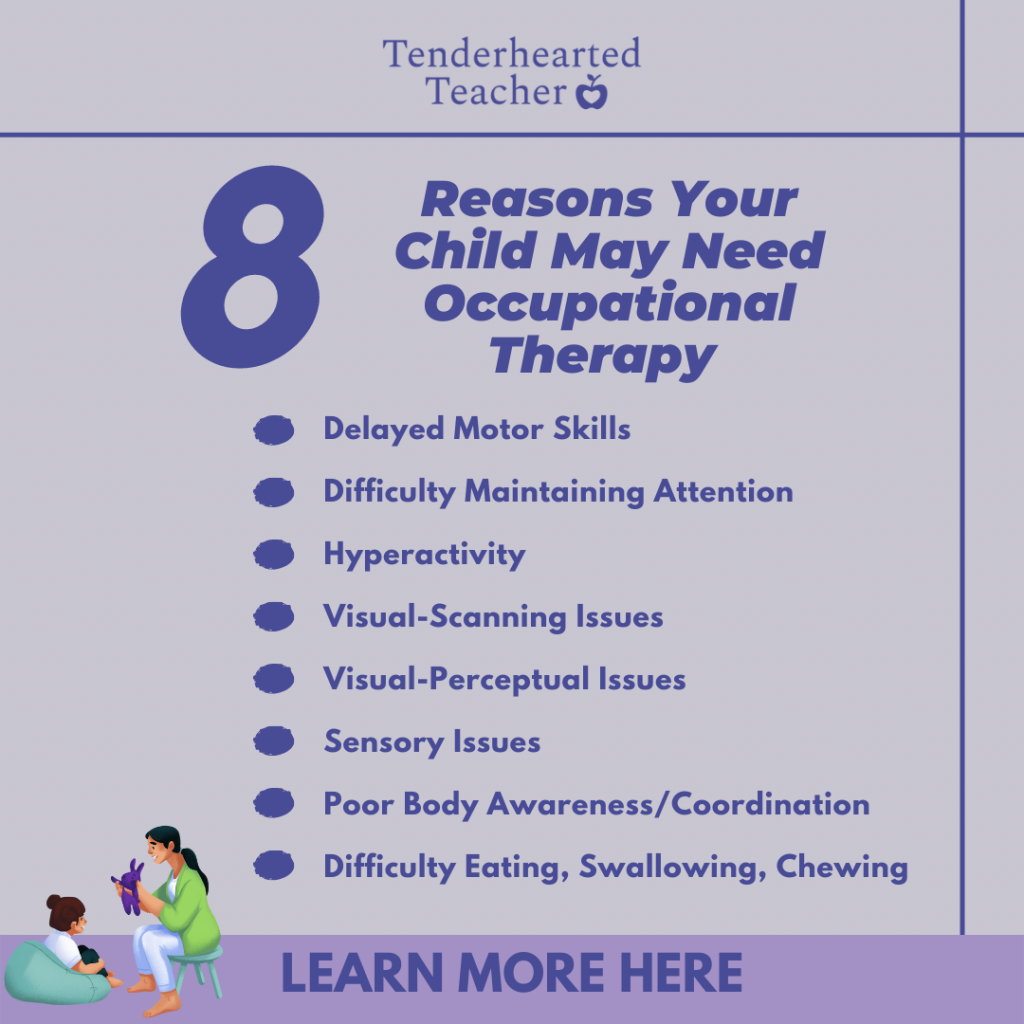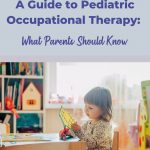
As parents to young children we often hear a lot about developmental milestones. In fact, I’m sure we’ve all had plenty of conversations–with just about everyone from our pediatricians to our in-laws– in regards to our child’s first words, first steps, etc. But, where do we turn when our child isn’t meeting their milestones? Over the next several weeks I will be writing a series of blog posts. These will help caregivers learn a little bit more about the types of services available to our children. This first post will focus on pediatric occupational therapy, specifically.
Stick around because I spoke with a certified occupational therapist. She shares some insight into the field as well as provides helpful information that all parents should know.
A Little Background Information
Recently, I wrote an introduction to special education. In it, I shared the differences between a 504 plan and an IEP. Additionally, I discussed referrals, evaluations, and the early intervention process. I’d advise you to read that before you move on because much of that information can be helpful here too.
With that said, many of my preschool disabled students–all of whom have IEPs– receive one or more related special services in addition to their special education program. But, what exactly are related services?
Under the federal special education law, Individuals with Disabilities Education Act (IDEA), related services can include programs like speech, physical, or occupational therapies, to name a few. Understood.org states, “Often, related services go hand in hand with special education.” However, this isn’t always the case. They go on to say that, “Different states and school districts deal with this in different ways. The federal law says states can decide to allow related services to be the only form of special education a child gets. In that case, the related service is a child’s specialized instruction.”
Regardless of the child’s individualized plan, related services are designed to provide children with opportunities to develop skills that help them in life as well as in the classroom.
What is Pediatric Occupational Therapy?
According to the American Occupational Therapy Association (AOTA), “Occupational therapy practitioners work with children, youth, and their families, caregivers, and teachers to promote active participation in activities or occupations that are meaningful to them.” They define occupations, for children and youth, as “activities that enable them to learn and develop life skills (e.g., preschool and school activities), be creative and/or derive enjoyment (e.g., play), and thrive (e.g., self-care and relationships with others) as both a means and an end.”
Christina Kirwin, MS/OTR, states that “Pediatric occupational therapists work to improve the function and independence of children and teens with developmental delays, mental illness, injuries, and/or physical illnesses/diseases.”
Why Might a Child Need Pediatric Occupational Therapy?
Sometimes people confuse physical therapy and occupational therapy. This is understandable because both services can assist patients with physical impairments or delays. However, occupational therapy also addresses other concerns such as sensory issues, visual processing, body and spatial awareness, and even feeding issues.
Below you’ll find a list of developmental delays to look out for at home with your little one. Please keep in mind this list is meant to be a general guide for children of all ages. It’s important to note that many of these skills might still be developing for toddlers and preschoolers. Therefore, the key is checking for consistent progress over time. If you feel like your child is not making adequate progress or if their skills are regressing, please notify your health care provider.
Furthermore, Kirwin states, “If you suspect a delay, then don’t wait to get an evaluation. Always go with your gut and see a specialist.”
Areas of Development to Watch

1. Delayed Fine and/or Gross Motor Skills
Children with fine-motor delays may have difficulty playing with age-appropriate toys and self-feeding (with or without utensils.) They may also have poor handwriting and/or poor hand-eye coordination. Similarly, gross motor concerns can include decreased balance and delayed (or skipped) physical milestones. For example, rolling, crawling, walking, running, jumping, or climbing stairs. Children may also struggle with catching, throwing, or kicking a ball.
2. Lack of Attention
Children with attending issues may have difficulty maintaining attention in class or in a conversation. They may also struggle to stay seated for any length of time. And they may even have a hard time remembering things.
3. Hyperactivity
Children with hyperactivity may exhibit impulsive behaviors such as difficulty with keeping their hands to themselves. They may also have decreased safety awareness.
4. Visual Scanning Issues
Children with visual scanning issues may have difficulty with reading a line of text without skipping to another line. They may also struggle with copying from a board or near-point. They can also find it difficult to find hidden pictures or words in a word search game.
5. Visual-Perceptual Issues
Similarly, children with visual-perceptual issues may have difficulty judging spatial distances between self and objects as well as taking note of details. They may also struggle with puzzles and copying shape designs.
6. Sensory Issues
Children with sensory issues may have an excessive sensory response to stimuli (too much or too little.) For example they may be impacted by movement, heights, sounds, touching/being touched, food textures, clothes, and/or lights. Additionally, they often appear to have difficulty following multi-step directions.
7. Poor Body Awareness
Children with poor body awareness appear to be “clumsy.” They may bump into objects, not notice food on their face, and their appearance may often look disheveled.
8. Feeding Issues
Children with feeding issues may have difficulty sucking, chewing, and/or swallowing. They may also struggle with holding utensils or drinking from cups. They often have poor postural control and have picky or messy eating habits. Additionally, they might pocket food in their cheeks.
What to Do If You Think Your Child Needs an Evaluation?
I should note that, from time to time, I have come across parents/caregivers who are apprehensive to have their child evaluated. While this can be a natural and understandable response, I want to reassure you that getting your child the support they need is the right choice. It is critical for their overall development. In fact, research has found that early interventions have positive effects on developmental outcomes.
According to the Centers for Disease Control and Prevention (CDC), “the connections in a child’s brain are most adaptable during the first three years of life. These connections, also called neural circuits, are the foundation for learning, behavior, and health. Over time, these connections become harder to change.” Therefore, the earlier an intervention is implemented, the better the potential outcome may be. This is why every state and territory in the country provides early intervention services (from birth to 3 years old) to help provide children and families with necessary supports and services.
If you suspect your child needs to be evaluated, regardless of their age, you should reach out to your child’s pediatrician. Another option is to contact your local school district. Either one can assist you with obtaining a developmental screening. In addition, they can provide information on the referral and evaluation process.
So, What Does A Pediatric Occupational Therapy Evaluation Look Like?
Kirwin described a typical OT evaluation. She stated they consist of parent interviews, clinical observation of the child, and standardized testing. First, she said that the baseline status is determined. Then, goals, based on the child’s deficits, are generated to be worked on in treatment. Generally, sessions can range from anywhere between 30 minutes to an hour. Length is typically based on the child’s needs. During a session, the child works with their therapist and engages in various activities to help reach their pre-determined goals.
What Can Parents Do to Support Their Child at Home?

Now that you have a better understanding of pediatric occupational therapy and what it entails, I’d like to share some suggestions on how to support your child at home. These tips are especially helpful at enhancing a child’s life skills and overall wellbeing. They focus on physical development, including gross and fine motor practice, sensory engagement, self-care and responsibility, healthy lifestyle choices, and cognitive activities. Kirwin has shared her most effective strategies below:
- Read books together as well as allow your child to read independently.
- Have your children do basic household chores and help with cooking.
- Maximize time outside on playgrounds.
- Get involved in extracurricular activities and sports (like swimming or dance.)
- Take walks together as a family out in nature.
- Engage in arts and crafts, do puzzles, peel stickers, and roll play dough.
- Maintain healthy eating and sleeping habits.
- Limit screen time.
Now talk to me! Did you learn something new today about pediatric occupational therapy? Tell me in the comments below!
REFERENCE: Handley More, D. (2015). Occupational Therapy’s Role with Children and Youth. AOTA. Retrieved June 4, 2022, from https://www.aota.org/~/media/Corporate/Files/AboutOT/Professionals/WhatIsOT/CY/Fact-Sheets/Children%20and%20Youth%20fact%20sheet.ashx
SAVE TO PINTEREST




This is great information. Thanks for sharing.
This was a very helpful post. We tried OT when my daughter just turned 3 because the pediatrician suspected sensory-seeking behavior. What we found out from the OT and the psychologist was that she didn’t have any kind of disorder. It was just her personality and temperament! I’m glad we went and got it all checked out early!
You make a great point, Dana. Evaluations can be used to rule out delays as well.
Thank you for this easy to understand guide! We just finished up several months of OT with my daughter and I know I had tons of questions before hand!
So much great info here. My toddler is all of these. Her doctor doesn’t seem to understand so after reading this it confirms I need a new doctor. Thank you.
This was very informative. Many new things for me!